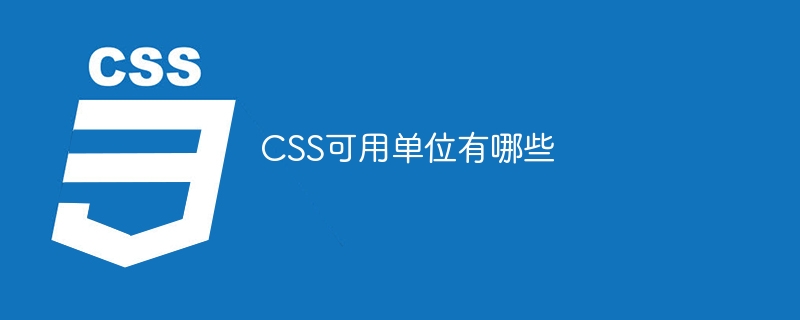Home >Web Front-end >CSS Tutorial >What units are available in CSS?
What units are available in CSS?
- 百草Original
- 2023-10-18 14:15:411037browse
CSS available units include pixels, percentage, em, rem, vw, vh, vmin, vmax, pt, cm, mm and in, etc. Detailed introduction: 1. Pixel is the most commonly used unit, which represents a physical pixel on the screen. Pixel is a relatively fixed unit and may correspond to different physical sizes on different devices; 2. The percentage unit is relative to the parent element. The size is calculated. For example, if the width of an element is set to 50%, then its width will be half the width of the parent element; 3. The em unit is relative to the font size of the element, etc.

The operating system for this tutorial: Windows 10 system, DELL G3 computer.
In CSS, there are a variety of units that can be used to specify the size, distance, and other properties of elements. These units can be divided into two categories: absolute units and relative units. The following are some commonly used CSS units:
1. Pixel (px): Pixel is the most commonly used unit, which represents a physical pixel on the screen. Pixel is a relatively fixed unit and may correspond to different physical sizes on different devices.
2. Percent (%): The percentage unit is calculated relative to the size of the parent element. For example, if an element's width is set to 50%, its width will be half the width of its parent element.
3. em (em): The em unit is calculated relative to the font size of the element. For example, if an element's font size is set to 2em, then its dimensions will be twice the font size of the parent element.
4. rem (rem): The rem unit is calculated relative to the font size of the root element (that is, the html element). Unlike em, the calculation of rem units is not affected by the font size of the parent element.
5. vw and vh: The vw and vh units represent the percentage of the viewport width and viewport height respectively. The viewport refers to the visible area of the browser window or device screen. For example, if an element's width is set to 50vw, then its width will be half the width of the viewport.
6. vmin and vmax: The vmin and vmax units represent the percentage of the smaller or larger value of the viewport width and viewport height respectively. For example, if an element's height is set to 50vmin, its height will be half the smaller of the viewport width or the viewport height.
7. pt (point): The pt unit is a commonly used unit of length in the printing industry. 1pt is equal to 1/72 inch.
8. cm (centimeter): The unit of cm is centimeter, and 1cm is equal to 10 millimeters.
9. mm (millimeter): The unit of mm is millimeter.
10. in (inch): The unit of in is inches, and 1 in is equal to 2.54 centimeters.
In addition to the above-mentioned commonly used length units, CSS also has some other relative units and absolute units, such as ex, ch, pc, etc. Their use is relatively limited and generally not commonly used for layout and size definition.
In actual development, choosing the appropriate length unit depends on specific needs and design requirements. Relative units (such as percentages, em, rem, etc.) are more suitable for responsive layout and mobile device development, while absolute units (such as pixels, centimeters, etc.) are more suitable for the definition of fixed-size elements and typography styles. At the same time, you need to pay attention to the conversion and compatibility between different units to avoid dimensional confusion or abnormal display.
In general, the available units for CSS include pixels, percentages, em, rem, vw, vh, vmin, vmax, pt, cm, mm and in, etc. Choosing the right units based on specific needs enables flexible layout and size definition, providing a good user experience.
The above is the detailed content of What units are available in CSS?. For more information, please follow other related articles on the PHP Chinese website!
Related articles
See more- How to set transparency in css? Two ways to set transparency (code examples)
- How to center img image with css? The display attribute of css implements image centering (code example)
- What are the basic units of C language?
- What is the basic unit of storage capacity?
- Is the unit of CAD in centimeters or millimeters?

